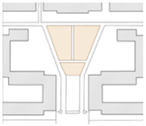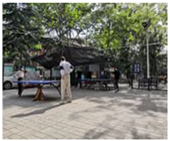Social Interaction in Public Spaces and Well-Being among Elderly Women: Towards Age-Friendly Urban Environments
Abstract
:1. Introduction
2. Materials and Methods
2.1. Observation and Data Collection
2.2. Mapping
2.3. Survey and Analysis
3. Results and Discussion
3.1. Social Interaction of Elderly Women
3.2. Public Space for Elderly Women’s Social Interaction
3.3. Principles of Age-Friendly Urban Space Shaping
4. Conclusions
Author Contributions
Funding
Institutional Review Board Statement
Informed Consent Statement
Data Availability Statement
Conflicts of Interest
References
- World Health Organization (WHO). Global Age-Friendly Cities: A Guide; WHO: Geneva, Switzerland, 2007. [Google Scholar]
- Phillips, D.; Siu, O.; Yeh, A.; Cheng, K. Ageing and the Urban Environment. In Ageing and Place: Perspectives, Policy, Practice; Andrews, G.J., Phillips, D.R., Eds.; Routledge: London, UK, 2005; pp. 147–163. [Google Scholar]
- Alidoust, S.; Holden, G.; Bosman, C. Urban Environment and Social Health of the Elderly: A Critical Discussion on Physical, Social and Policy Environments. Athens J. Health 2014, 1, 169–180. [Google Scholar] [CrossRef]
- Koipysheva, E.A.; Lebedinsky, V.Y.; Koipysheva, M.A. Physical Health (Definition, Semantic Content, Study Prospects). In Proceedings of the International Conference on Research Paradigms Transformation in Social Science, Irkutsk, Russia, 26–28 April 2018; Future Academy: Irkutsk, Russia, 2018. [Google Scholar]
- Little, W. Introduction to Sociology, 2nd ed.; XanEdu Publishing Inc.: Ann Arbor, MI, USA, 2015. [Google Scholar]
- Caro, F.G.; Fitzgerald, K.G. International Perspectives on Age-Friendly Cities; Routledge: New York, NY, USA, 2016. [Google Scholar]
- Hoof, J.V.; Kazak, J.K.; Perek-Bialas, J.M.; Peek, S.T.M. The Challenges of Urban Ageing: Making Cities Age-Friendly in Europe. Int. J. Environ. Res. Public Health 2018, 15, 2473. [Google Scholar] [CrossRef] [PubMed] [Green Version]
- Brewer, M.B. A Dual-process Model of Impression Formation. In Advances in Social Cognition; Srull, T.K., Wyer, R.S., Eds.; Lawrence Erlbaum: Mahwah, NJ, USA, 1988; Volume 1, pp. 1–36. [Google Scholar]
- Fiske, S.T. Stereotyping, Prejudice, and Discrimination. In The Handbook of Social Psychology, 4th ed.; Gilbert, D.T., Fiske, S.T., Lindzey, G., Eds.; McGraw-Hill: New York, NY, USA, 1998; Volume 2, pp. 357–411. [Google Scholar]
- Bieman-Copland, S.; Ryan, E.B. Social Perceptions of Failures in Memory Monitoring. Psychol. Aging 2001, 16, 357–361. [Google Scholar] [CrossRef] [PubMed]
- Hummert, M.L.; Garstka, T.A.; Shaner, J.L. Stereotyping of Older Adults: The Role of Target Facial Cues and Perceiver Characteristics. Psychol. Aging 1997, 12, 107–114. [Google Scholar] [CrossRef]
- Montepare, J.M.; Zebrowitz-McArthur, L. Impressions of People Created by Age-related Qualities of their Gaits. J. Personal. Soc. Psychol. 1988, 55, 547–556. [Google Scholar] [CrossRef]
- Alves, F.B.; Mendes, L.T. Urban Design and Ageing-public Space for Elderly People in Residential Areas, Proceedings of Planning and Aging—Think, Act and Share Age-Friendly Cities, Porto, Spain, 31 January 2012; Colecção—Documentos Técnicos: Porto, Spain, 2012. [Google Scholar]
- Neugarten, B. Age Groups in American Society and the Rise of the Young-old. Ann. Am. Acad. Political Soc. Sci. 1974, 9, 187–198. [Google Scholar] [CrossRef]
- Richeson, J.A.; Shelton, J.N. A Social Psychological Perspective on the Stigmatization of Older Adults. In When I’m 64; Carstensen, L.L., Hartel, C.R., Eds.; The National Academies Press: Washington, DC, USA, 2006; pp. 174–208. [Google Scholar]
- Braithwaite, V.; Gibson, D.; Holman, J. Age Stereotyping: Are We Oversimplifying the Phenomenon? Int. J. Aging Hum. Dev. 1986, 22, 315–325. [Google Scholar] [CrossRef] [PubMed]
- Brewer, M.B.; Dull, V.; Lui, L.L. Perceptions of the Elderly: Stereotypes as Prototypes. J. Personal. Soc. Psychol. 1981, 41, 656–670. [Google Scholar] [CrossRef]
- Brewer, M.B.; Lui, L.N. Categorization of the Elderly by Elderly: Effects of Perceiver’s Category Membership. Personal. Soc. Psychol. Bull. 1984, 10, 585–595. [Google Scholar] [CrossRef]
- Hummert, M.L. Multiple Stereotypes of Elderly and Young Adults: A Comparison of Structure and Evaluations. Psychol. Aging 1990, 5, 82–193. [Google Scholar] [CrossRef]
- Hummert, M.L. Physiognomic Cues and the Activation of Stereotypes of the elderly in Interaction. Int. J. Aging Hum. Dev. 1994, 39, 5–20. [Google Scholar] [CrossRef] [PubMed]
- Schmidt, D.F.; Boland, S.M. Structure of Perceptions of Older Adults: Evidence for Multiple Stereotypes. Psychol. Aging 1986, 1, 255–260. [Google Scholar] [CrossRef] [PubMed]
- Carmel, S. Health and Well-Being in Late Life: Gender Differences Worldwide. Front. Med. 2019, 6, 218. [Google Scholar] [CrossRef] [PubMed] [Green Version]
- Chen, G.; Liu, L.; Yu, J. A Comparative Study on Strength between American College Male and Female Students in Caucasian and Asian Populations. Sport Sci. Rev. 2012, 21, 153–165. [Google Scholar] [CrossRef]
- Ventura Orthopedics. Available online: https://venturaortho.com/do-people-really-shrink-with-age/ (accessed on 29 October 2021).
- Ortiz-Ospina, E.; Beltekian, D. Why Do Women Live Longer Than Men? Available online: https://ourworldindata.org/why-do-women-live-longer-than-men (accessed on 14 August 2018).
- Barford, A.; Dorling, D.; Smith, G.D.; Shaw, M. Life Expectancy: Women Now on Top Everywhere: During 2006, Even in the Poorest Countries, Women Can Expect to Outlive men. BMJ 2006, 4, 332–808. [Google Scholar]
- Leon, D.A. Trends in European Life Expectancy: A Salutary View. Int. J. Epidemiol. 2011, 40, 271. [Google Scholar] [CrossRef] [PubMed] [Green Version]
- Crimmins, E.M.; Shim, H.; Zhang, Y.S.; Kim, J.K. Differences between Men and Women in Mortality and the Health Dimensions of the Morbidity Process. Clin. Chem. 2018, 65, 288–332. [Google Scholar] [CrossRef] [PubMed] [Green Version]
- Wang, L. An Analysis on Elderly Women and Social Service Demands. J. China Women’s Univ. 2016, 28, 47–54. [Google Scholar]
- Clarke, P.; Nieuwenhuijsen, E.R. Environments for healthy ageing: A critical review. Maturitas 2009, 64, 14–19. [Google Scholar] [CrossRef]
- Donald, C.A.; Ware Jr, J.E.; Brook, R.H.; Davies-Avery, A. Conceptualization and Measurement of Health for Adults in the Health Insurance Study: Vol.V, General Health Perceptions; Rand Corporation: Santa Monica, LA, USA, 1978. [Google Scholar]
- Fietkau, J.; Stojko, L. A System Design to Support Outside Activities of Older Adults Using Smart Urban Objects, Proceedings of 18th European Conference on Computer-Supported Cooperative Work, Siegen: Germany, 14–17 June 2020; University of Siegen: Siegen, Germany, 2020. [Google Scholar]
- Patil, D.R.; Raj, M.P. Designing Urban Public Spaces for Walkable Mobility of Elderly Residents: A Model of Assessment & Strategic proposals-Case of Bangalore City, India. In Proceedings of the 8th Zero Energy Mass Custom Home International Conference, Dubai, United Arab Emirates, 26–28 October 2021; Science Publishing: New York, NY, USA, 2021; pp. 1–25. [Google Scholar]
- Peace, S.; Kellaher, L.; Holland, C. Making Space for Identity Critical Approaches to Ageing and Later Life; McGraw-Hill Education: New York, NY, USA, 2005. [Google Scholar]
- Moran, M.; Cauwenberg, J.V.; Hercky-Linnewiel, R.; Cerin, E.; Deforche, B.; Plaut, P. Understanding the Relationships Between the Physical Environment and Physical Activity in Older Adults: A Systematic Review of Qualitative Studies. Int. J. Behav. Nutr. Phys. Act. 2014, 11, 79. [Google Scholar] [CrossRef] [PubMed] [Green Version]
- Bruchert, T.; Baumgart, S.; Bolte, G. Social Determinants of Older Adults’ Urban Design Preference: A Cross-sectional Study. Cities Health 2021, 2, 1–15. [Google Scholar] [CrossRef]
- Beijing Municipal Bureau of Statistics. Beijing Municipal Bureau of Statistics and NBS Survey Office in Beijing. Available online: http://nj.tjj.beijing.gov.cn/nj/main/2019-tjnj/zk/indexeh.htm (accessed on 24 January 2019).
- National Bureau of Statistics. 7th National Census. Available online: http://www.stats.gov.cn/ztjc/zdtjgz/zgrkpc/dqcrkpc/ (accessed on 19 October 2021).
- Keats Baiwanzhuang. Available online: https://keatschinese.com/china-culture-resources/baiwanzhuang/ (accessed on 5 October 2021).
- Beijing Municipal Commission of Planning and Natural Resources. Detailed Regulatory Plan for the Functional Core Area of the Capital. Available online: http://ghzrzyw.beijing.gov.cn/zhengwuxinxi/ghcg/xxgh/sj/202008/t20200829_1993379.html (accessed on 10 November 2021).
- Anjuke Beijing. Households in Communities of Beijing. Available online: https://beijing.anjuke.com (accessed on 21 September 2021).
- Beijing News. Three Generations of Aunts in Xicheng District. Available online: https://baijiahao.baidu.com/s?id=1646074738226574989&wfr=spider&for=pc (accessed on 15 September 2021).
- Autodesk, Inc. History. Available online: http://www.fundinguniverse.com/company-histories/autodesk-inc-history/ (accessed on 10 September 2021).
- Autodesk, Inc. Chapter 8: Autodesk and AutoCAD. Available online: http://cadhistory.net/08%20Autodesk%20and%20AutoCAD.pdf (accessed on 20 March 2016).
- Centers for Disease Control and Prevention. Healthy Places Terminology-Aging in Place. Available online: https://www.cdc.gov/healthyplaces/terminology.htm (accessed on 15 September 2021).
- Wiles, J.L.; Leibing, A.; Guberman, N.; Reeve, J.; Allen, R.E.S. The Meaning of “Aging in Place” to Older People. Gerontologist 2012, 52, 357–366. [Google Scholar] [CrossRef]
- Sarkissian, W.; Stenberg, B. Guidelines for Planning for Older People in Public Open Space. Available online: https://sarkissian.com.au/wp-content/uploads/sites/13/2013/09/Older-people-in-residential-public-open-space.pdf (accessed on 31 December 2013).
- Brach, J.S.; VanSwearingen, J.M. Interventions to Improve Walking in Older Adults. Curr. Transl. Geriatr. Exp. Gerontol. Rep. 2014, 4, 230–238. [Google Scholar] [CrossRef] [PubMed] [Green Version]
- Center for Aging Better. Putting Older People at the Heart of Urban Transformation. Available online: https://ageing-better.org.uk/blogs/putting-older-people-heart-urban-transformation (accessed on 15 September 2021).
- Temelova, J.; Slezakova, A. The Changing Environment and Neighborhood Satisfaction in Socialist High-Rise Panel Housing Estates: The Time-Comparative Perceptions of Elderly Residents in Prague. Cities 2014, 37, 82–91. [Google Scholar] [CrossRef]
- Yung, E.H.K.; Conejos, S.; Chan, E.H.W. Social Needs of the Elderly and Active Aging in Public Open Spaces in Urban Renewal. Cities 2016, 52, 114–122. [Google Scholar] [CrossRef]






| Public Space | Plan | Characteristics | Infrastructure | Photos |
|---|---|---|---|---|
| Central square of Neighborhood Mou |  | Concentrated open space Direct connections to surroundings both visual and physical Vibrant activities | Ping pong tables Benches Fitness equipment |  |
| Clear area of Neighborhood Chen |  | In front of residential buildings Close to the community entrance Convenient access Dull space shaping | Benches |  |
| Clear area of Neighborhood Zhongli |  | Informal public space Convenient access Used by close neighborhoods | Benches |  |
| Public Space | Plan | Characteristics | Infrastructure | Photos |
|---|---|---|---|---|
| Central square of Community Luyuan |  | Concentrated open space Direct connections to surroundings both visual and physical Vibrant activities | Wood gallery Benches |  |
| Clear area of Neighborhood Nanluyuan |  | In front of residence buildings Conveniently accessed Low outdoor thermal comfort during daytime | Benches Fitness equipment |  |
| Corner area of Neighborhood Nanluyuan |  | Informal public space Conveniently accessed Used by close neighborhoods | Benches |  |
| Public Space | Plan | Characteristics | Infrastructure | Photos |
|---|---|---|---|---|
| Green space of No.3 Residence Building |  | Formal open space with large scale Direct connections to surroundings both visual and physical Vibrant activities | Wood gallery Benches |  |
| Green space of No.7 Residence Building |  | In front of residence buildings Conveniently accessed Close to secondary road | Wood gallery Benches Chinese chess table |  |
| Small square aside Property Management Office |  | Conveniently accessed Close to secondary road | Fitness equipment Sandpit |  |
Publisher’s Note: MDPI stays neutral with regard to jurisdictional claims in published maps and institutional affiliations. |
© 2022 by the authors. Licensee MDPI, Basel, Switzerland. This article is an open access article distributed under the terms and conditions of the Creative Commons Attribution (CC BY) license (https://creativecommons.org/licenses/by/4.0/).
Share and Cite
Zhang, Y.; Chen, G.; He, Y.; Jiang, X.; Xue, C. Social Interaction in Public Spaces and Well-Being among Elderly Women: Towards Age-Friendly Urban Environments. Int. J. Environ. Res. Public Health 2022, 19, 746. https://doi.org/10.3390/ijerph19020746
Zhang Y, Chen G, He Y, Jiang X, Xue C. Social Interaction in Public Spaces and Well-Being among Elderly Women: Towards Age-Friendly Urban Environments. International Journal of Environmental Research and Public Health. 2022; 19(2):746. https://doi.org/10.3390/ijerph19020746
Chicago/Turabian StyleZhang, Yingyi, Ge Chen, Yue He, Xinyue Jiang, and Caiying Xue. 2022. "Social Interaction in Public Spaces and Well-Being among Elderly Women: Towards Age-Friendly Urban Environments" International Journal of Environmental Research and Public Health 19, no. 2: 746. https://doi.org/10.3390/ijerph19020746
APA StyleZhang, Y., Chen, G., He, Y., Jiang, X., & Xue, C. (2022). Social Interaction in Public Spaces and Well-Being among Elderly Women: Towards Age-Friendly Urban Environments. International Journal of Environmental Research and Public Health, 19(2), 746. https://doi.org/10.3390/ijerph19020746






